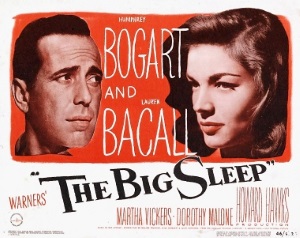
There are many reasons why every film aficionado should watch The Big Sleep. It is regularly cited as one of the greatest films of all time, being included for example in Roger Ebert’s list of Great Movies. It always appears at or near the top of lists of the best noir films. It’s based on the best known novel by Raymond Chandler with scriptwriting assistance from no less a literary figure than William Faulkner. The pairing of Humphrey Bogart and Lauren Bacall is one of the most famous romances that take place both on-screen and in real-life. In particular, Bacall’s death in August of this year elicited a renewed surge of interest in the films that they appeared in together.
Yet, sitting down to watch it, I couldn’t help but feel that I was missing something. Don’t get me wrong, I found it to be excellent and eminently watchable. I enjoyed being immersed in this dark world in which everyone is lying and has something to hide. I found how the film meticulously tracks how Marlowe plausibly follows clues to crack the case to be fascinating. He’s comes across as a professional detective whose unassuming exterior hides a powerfully intuitive mind. And of course, the dialogue is wonderfully clever and the interplay between Bogart and Bacall is a lot of fun.
But as your mind works hard to make sense of the convoluted plot, the answers that come back don’t always feel satisfactory. The most famous of these plot holes is how no one, not even director Howard Hawks nor Chandler himself, knew who killed the chauffeur. Another is how Marlowe starts trying to solve the cipher he obtains from Geiger, is interrupted and never cares about it again. Then there’s how Marlow finally learns the location of the elusive Mona Mars from Geiger’s secretary, who herself only knows about it by pure happenstance. Roger Ebert excuses this by saying that this is a film about the process of investigation, not about its results, but I find it hard to respect a noir if the plot never actually goes anywhere interesting.
Others opine that the heart of this film is really in the relationship between Marlowe and Vivian Sternwood. I certainly consider the highlight of the film but to me, it doesn’t feel like their interactions dominate the film in the way that Cary Grant and Rosalind Russell did in His Girl Friday. Recalling Hawks’ famous dictum that a good film is “three good scenes, no bad ones”, I find it an apt descriptor for The Big Sleep. Every scene in this film is good. They flow well together, capture your attention and entertain you. But taken as a whole, the film feels like it lacks a central core. It’s good but it doesn’t seem worthy of being called great.
While puzzling over this, I downloaded the novel (it is arguably out of copyright in many countries and readily) available and started reading it. I’m nowhere near finished and it’s clear that plot holes that exist in the film also exist in the original novel, but I find its handling of the story much more satisfying. Marlowe actually notices the chauffeur and his car during his first visit to the Sternwood house so when he subsequently ends up dead, it doesn’t feel jarring. There’s also a scene which doesn’t appear in the film where Marlowe meets with the police and the District Attorney to settle the legal side of things and conveniently summarize what happened so far to the reader. This means that while the plot isn’t exactly rock solid, it’s still easy for the reader to follow and understand.
From all this, I hesitantly conclude that this film really is a product of its time and that you needed to be there to really love it the way that so many critics seem to. Its charm is very much all about how Bogart played Marlowe (which even I preferred to the book version which reads to my modern eyes like a pastiche of noir detectives), about the classical beauty of the many ladies Hawks cast for this film, and about how it captured the spirit and atmosphere of the noir genre. It’s also about delighting in the clever ways in which Hawks worked around the limits of the era, such as the extensive use of sexual double entendres and how he expressed the moral depravity of the criminals’ actions without being able to depict or even describe them. For some, I suspect that it must also have been about being fans of Chandler and the novel and being happy to see it adapted to the big screen.
Not being a fan of Chandler or even crime fiction in general and living in an era where such moral limits in cinema are relics of the past, none of these really strike much of a chord with me. Even Geiger’s profession as stated in the novel, being someone who rents out pornographic books for a living, feels unbelievably quaint to me. So as far I’m concerned, The Big Sleep is an excellent film but not a great one and there are certainly other films that I think are better examples of the noir genre such as Orson Welles’ Touch of Evil or the more recent L.A. Confidential.
One thought on “The Big Sleep (1946)”